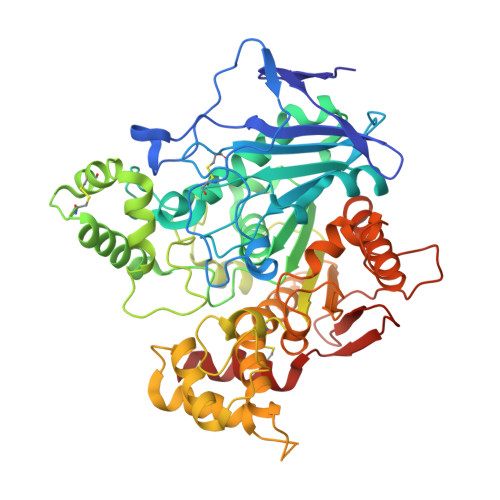Structure-Activity Analysis of Aging and Reactivation of Human Butyrylcholinesterase Inhibited by Analogues of Tabun
Carletti, E., Aurbek, N., Gillon, E., Loiodice, M., Nicolet, Y., Fontecilla, J., Masson, P., Thiermann, H., Nachon, F., Worek, F.(2009) Biochem J 421: 97
- PubMed: 19368529
- DOI: https://doi.org/10.1042/BJ20090091
- Primary Citation of Related Structures:
2WID, 2WIF, 2WIG, 2WIJ, 2WIK, 2WIL, 2WSL - PubMed Abstract:
hBChE [human BChE (butyrylcholinesterase)] naturally scavenges OPs (organophosphates). This bioscavenger is currently in Clinical Phase I for pretreatment of OP intoxication. Phosphylated ChEs (cholinesterases) can undergo a spontaneous time-dependent process called 'aging' during which the conjugate is dealkylated, leading to creation of an enzyme that cannot be reactivated. hBChE inhibited by phosphoramidates such as tabun displays a peculiar resistance to oxime-mediated reactivation. We investigated the basis of oxime resistance of phosphoramidyl-BChE conjugates by determining the kinetics of inhibition, reactivation (obidoxime {1,1'-(oxybis-methylene) bis[4-(hydroxyimino) methyl] pyridinium dichloride}, TMB-4 [1,3-trimethylene-bis(4-hydroxyiminomethylpyridinium) dibromide], HLö 7 {1-[[[4-(aminocarbonyl) pyridinio]methoxy]methyl]-2,4-bis-[(hydroxyimino)methyl] pyridinium dimethanesulfonate)}, HI-6 {1-[[[4-(aminocarbonyl) pyridinio] methoxy] methyl]-2-[(hydroxyimino)methyl]pyridinium dichloride monohydrate} and aging, and the crystal structures of hBChE inhibited by different N-monoalkyl and N,N-dialkyl tabun analogues. The refined structures of aged hBChE conjugates show that aging proceeds through O-dealkylation of the P(R) enantiomer of N,N-diethyl and N-propyl analogues, with subsequent formation of a salt bridge preventing reactivation, similarly to a previous observation made on tabun-ChE conjugates. Interestingly, the N-methyl analogue projects its amino group towards the choline-binding pocket, so that aging proceeds through deamination. This orientation results from a preference of hBChE's acyl-binding pocket for larger than 2-atoms linear substituents. The correlation between the inhibitory potency and the N-monoalkyl chain length is related to increasingly optimized interactions with the acyl-binding pocket as shown by the X-ray structures. These kinetics and X-ray data lead to a structure-activity relationship that highlights steric and electronic effects of the amino substituent of phosphoramidate. This study provides the structural basis to design new oximes capable of reactivating phosphoramidyl-hBChE conjugates after intoxication, notably when hBChE is used as pretreatment, or to design BChE-based catalytic bioscavengers.
Organizational Affiliation:
Unité d'Enzymologie, Département de Toxicologie, Centre de Recherches du Service de Santé des Armées (CRSSA), 24 av des Maquis du Grésivaudan, 38700 La Tronche, France.



















